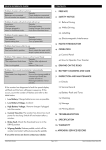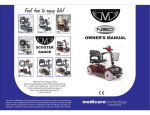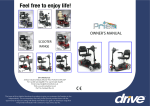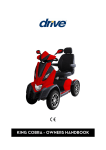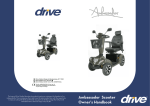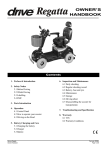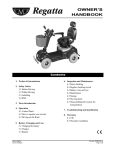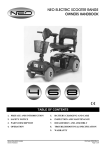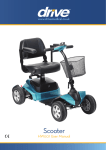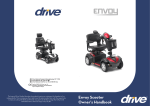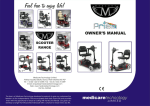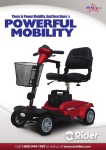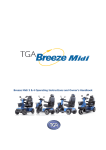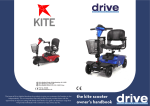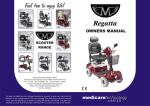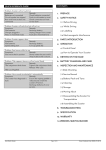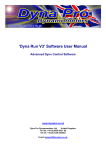Download User Manual
Transcript
www.drivemedical.co.uk The Team at Drive Medical develops its products to give our customers the freedom to live independently. This encompasses their daily home life and provides them with the opportunity to enjoy an outing with family and friends. Our goal is to develop a range that will provide individuals with a chance to enjoy every day life. Dealer Stamp Drive Medical Limited Ainleys Industrial Estate, Elland West Yorkshire, HX5 9JP Tel: +44 (0) 1422 314 488 Fax: +44 (0) 1422 314 489 Email: [email protected] www.drivemedical.co.uk Viper Scooter User Manual CONTENTS 1. PREFACE 2. SAFETY NOTICE 2.1 Before Driving In the event of a fault being detected, the 3 left most LEDs on the battery gauge will flash green followed by the 3 right most LEDs flashing red. This sequence will continue for approximately 15 seconds until the fault is displayed by one of the LEDs flashing. 2.2 Whilst Driving 2.3 Labelling The battery gauge will continue flashing until the fault is rectified and the key switch has been cycled 1st LED solid RED 2nd LED flash RED d 2.4 Electromagnetic Interference Low battery, battery voltage has dropped below 23.3v. Recharge batteries as soon as possible. **----1st Led flash RED *------ All LEDs Flash ******* 2nd LED flash RED d -*----- 3rd LED Flash RED --*---- 4th LED Flash AMBER ---*--5th LED Flash GREEN ----*-6th LED Flash GREEN -----*7th LED Flash GREEN ------* 3. PARTS INTRODUCTION 4. OPERATION Battery voltage too low. Voltage has dropped below 16.5v. Recharge batteries then check the battery, connections and wiring. 4.1 Control Panel 4.2 How to Operate Your Scooter Battery voltage too high. Unplug charger from scooter. Turn the scooter off and on. Reduce speed down any gradients to minimize regenerative charging. 5. DRIVING ON THE ROAD 6. BATTERY CHARGING AND CARE Current limit time-out/controller too hot. The scooter may have stalled. Turn the scooter of and leave for a few minutes before turning back on. Check connections 7. INSPECTION AND MAINTENANCE 7.1 Checks Brake fault. either a park brake release switch or the park brake is faulty, check brake and all connections, ensure the freewheel lever is in DRIVE 7.2 Service Record 7.3 Battery Pack and Tyres Out of neutral at power up. Return wigwag paddle to neutral then turn off and on again. 7.4 Cleaning Speed pot Error. Wigwag paddle or its wiring is faulty. Check for open or short circuits and wigwag paddle is calibrated 7.5 Storage 7.6 Moving About Motor volts Error. Motor or its wiring is faulty. Check paddle is calibrated and check for open or short circuits. 8. TROUBLESHOOTING Internal controller fault. Check all connections and wiring. If problem persists, contact Drive Medical Ltd 9. SPECIFICATION 10. WARRANTY 11. APPENDIX: SERVICE RECORD Viper Electric Scooter Page 1 of 16 Owner’s Handbook (Code: Viper_IFU) 1. PREFACE AND INTRODUCTION Please carefully read this owner’s handbook before using the scooter to ensure that you operate the scooter safely. Improper use of the scooter could result in damage, injury or traffic accidents. This handbook also advises how to get the most out of your scooter by giving comprehensive operating, assembly and maintenance instructions for the scooter. A repair and maintenance record chart and warranty information is included with this handbook. Please keep it in a safe place or with the scooter. 2. SAFETY Before Driving The user needs to be familiar with the use and operation of this scooter before driving. The scooter may only be driven on the pavement or pedestrian areas at speeds up to 4mph (6.4kph). Use the High / Low button on the lower setting to ensure you do not exceed this speed. The scooter may be driven on single carriage roads with the button set to High. This will allow speeds up to 8mph (12.8kph). Be aware of traffic and other road users when crossing or using roads. If someone else uses the scooter make sure that you provide him or her with this handbook for their consideration. Never ride on motorways or dual carriageways. As designs change some of the illustrations and pictures in the manual may not correspond to the scooters that you purchased. We reserve the right to make design modifications. Do not drive the scooter under the influence of drink or drugs, or when you are tired. Driving under the influence of alcohol or drugs may be an offence under the Road Traffic Act. The Viper scooter has been designed and manufactured to provide a comfortable and secure yet affordable solution for some mobility requirements. It is suitable for mainly road and outdoor use and has a top speed of 8mph. It can be used indoors and on the pavement where the environment permits and when the scooter is set to the indoor speed setting. It is a class 3 scooter as defined by the Road Traffic Act 1988. Be careful when using the scooter in low light. Use extreme caution when driving your scooter in busy areas such as shopping malls. Before using the scooter in busy or hazardous environments, familiarise yourself with the operation of the scooter. Practice in an open and safe area which is free from hazards and other people. Reduce your speed to a minimum for your initial practice. Practice operating your vehicle Before using the scooter in busy or potentially dangerous areas, familiarize yourself with the operation of your scooter. Please practice in a wide and open area like a park. In order to avoid accidents with your scooter whilst driving, bear in mind driving motions such as accelerating, braking, turning, reversing and gradients. 1. Reduce your speed to a minimum for your initial practice 2. For safety, ensure somebody accompanies you when driving on the road for the first time 3. Only use the higher speed setting when you are confident that you can easily operate and control your scooter Viper Electric Scooter Page 2 of 16 Owner’s Handbook (Code: Viper_IFU) The Viper scooter can only be used by one person at a time. Do not carry passengers on your scooter (including children) Maximum user mass (weight capacity) The maximum weight that can be carried is 160kg / 25 stone (including occupant and any goods). Do not use the scooter to carry or haul goods. Whilst Driving Warning Always re-engage the anti-freewheel device before use. Failure to do so may result in injury. Do not move your body out of the vehicle whilst moving Such action may cause you to lose your balance and risk injury from falling Pay attention that your clothing and other garments do not get tangled or caught in the wheels Do not use your vehicle in the following environments On roads with heavy traffic or roads that are muddy, gravelly, bumpy, narrow, snowed over or icy. Places where you might get the wheels stuck. On canal towpaths which are not guarded by any fence or hedge. Do not drive at night or if it is raining heavily, snowing, misty or windy. Do not drive your vehicle in an ‘S’ pattern or make erratic turnings. Do not take the scooter onto escalators. Under no circumstances should the scooter be used as a seat in a motor vehicle (e.g. cars, buses, trains, etc) Do not set in freewheel mode when driving on a gradient. To protect your safety, the power will automatically cut off and the electromagnetic (EM) brake will activate while you are driving down gradients over 15º. This will limit the speed to a safe level. Switch the power off and on again to restart your scooter. Step and Obstacle Climbing The scooter is capable of climbing an 80mm (3”) obstacle from a stationary start or a 100mm (4”) obstacle from a moving start. The ground clearance of the scooter is 100mm (4”). To climb an obstacle when moving, start moving at least 50cmm (20”) from the obstacle and mount the obstacle head on (not at an angle). However, this method is not recommended as this may cause damage and/or injury. Gradients and Drops Do not drive on roads with large drops or potholes. Such drops or potholes may cause damage and/or injury. Do not cross wide water gutters where there is a risk of getting the wheels stuck. Always use a low speed setting when ascending or descending a gradient. Do not drive on gradients steeper than those stated on the diagram below: Viper Electric Scooter Page 3 of 16 Owner’s Handbook (Code: Viper_IFU) 3. PARTS INTRODUCTION 4. OPERATION 4.1 Control Panel Viper Electric Scooter Page 5 of 16 Owner’s Handbook (Code: Viper_IFU) 4.2 How To Operate Your Scooter Key Ignition. The key ignition acts as the power switch for the scooter. To switch the power on, turn the key clockwise and control panel should illuminate. To switch the power off, turn the key anticlockwise, after which the control panel should switch off and the key can be removed. Do not turn the ignition off whilst driving as this will lead to an emergency stop and possible risk of damage or injury. Wigwag Paddle. The scooter is propelled by the user operating the wigwag paddle at the bottom of the control panel. To move the scooter forward, move the right hand side of the paddle towards the user. To reverse the scooter, move the left hand side of the lever. The further the paddle moves, the faster the scooter will travel. To stop the scooter, release the wigwag paddle and the electromagnetic brake will apply automatically. Warning Do not push both left and right hand sides of the wigwag simultaneously. You will not be able to control the scooter. Braking. The electromagnetic brake will stop the scooter when the wigwag paddle is released. The brake is also automatically applied when the scooter is switched off. In the event of an emergency, the user can stop the scooter by operating the hand brake located on the left hand side of the tiller handlebars. When on a gradient, never set the vehicle to freewheel mode. The brakes will not be applied. Top Speed Setting. The top speed of the scooter can be increased by pressing the Hare button, or reduced by pressing the Tortoise button. The top speed is displayed on the control panel. The more segments of the display that are lit, the faster the scooter will go. High / Low Speed Setting. When the scooter is used indoors or in pedestrian environment (such as on the pavement or in a shopping mall) the Low speed setting should be engaged. When the scooter is used on the road, the high speed setting may be engaged. To engage the Low Speed Setting, press the bottom half of the button (marked ‘L’) and this will limit the scooter’s top speed to 4mph. To engage the High Speed Setting, press the top half of the button (marked ‘H’) and this will allow the scooter to have an 8mph top speed. Warning Always engage the Low Speed setting when travelling indoors or the pavement. This is a legal requirement. Horn Button. Press the horn button to sound the horn, Release the button to stop the horn. Indicator Buttons. Use the relevant indicators when making a turn to show your direction of travel. Press the Right or Left Indicator button once to operate the relevant indicators. Press the same button again to stop the indicators. Lights Button. Press the Lights button once to switch on the lights. Press the button again to switch off the lights. Hazard Warning Button. Press the Hazard Warning button once to switch on the warning function. Press the button again to switch off the function. When operating the Hazard Warning will flash all of the indicators and sound the horn. Battery Gauge. The amount of power remaining in the battery is shown by this gauge. A fully charged battery will show all the segments of the gauge lit, and the number of segments lit will reduce as the power decreases. If the battery gauge flashes but the scooter will still drive, then this indicates low battery power and the batteries should be recharged immediately. If it is not driving the check flash codes on page 1. Do not adjust the speed setting whilst driving as this could result in loss of control. Do not set the highest speed whilst driving indoors. Viper Electric Scooter Page 6 of 16 Owner’s Handbook (Code: Viper_IFU) Seat. The seat can rotate 360° and locks in 45° settings. To rotate, lift up the lever (A) located underneath the left hand side of the seat and swivel seat. Release the lever and carry on swiveling the seat until it locks in position. You can adjust the amount of legroom on the scooter by sliding the seat back and forth. To slide the seat, lift up the seat sliding handle (B). Located on the right of the seat. Then adjust the seat to correct position, release the handle and continue sliding the seat until it locks in position. To alter the backrest angle, pull up on the seat recline lever, then adjust the backrest to the required position and release the lever. Please note if nobody is using the backrest when the lever is operated, it will automatically spring the backrest forward to fold the seat. Armrest Adjustment. To adjust the height of the armrest, loosen the adjustment knob on the side of the armrest by Turning anticlockwise. Adjust the armrest to the required height and tighten the adjustment knob by turning clockwise. To adjust the angle of the armrest, flip up the armrest and reposition the jam nut with a spanner to alter the angle of the armrest. Tiller Adjustment The tiller can be adjusted into several positions. 1. Push (or pull) the lever on the scooter tiller (shown below) to adjust the tiller to the position you require. 2. Release the lever to lock the tiller. Circuit Breaker. The circuit breaker may trip when the scooter is under excessive load or when travelling on steep inclines. It will be more prone to tripping when the scooter is low on battery charge. Under normal conditions the circuit breaker button will protrude by 2mm – 3mm. If the circuit breaker has tripped the button will protrude by 7mm. To reset the circuit breaker, push the button in and the scooter should operate as normal. Attention. Return the seat to the forward position before driving. The circuit breaker is located on the left hand side of the rear of the frame, behind the back bumper. Viper Electric Scooter Page 7 of 16 Owner’s Handbook (Code: Viper_IFU) Freewheel Lever The freewheel levers allows the automatic brake to be disengaged so the scooter can be manually pushed and/or manoeuvred. When in freewheel mode the brakes are not applied so it should not be used when: 1. Using the USB power socket The scooter features a double USB power socket which can be used to power or charge numerous small devices such as satellite navigation systems, tablet computers and MP3 players for example Somebody is sat on the scooter The power socket is located in the front of the tiller. To use facility, first rotate the cover as shown by the arrow in the photo below. Then insert the USB cable from the device in to the socket and switch on the scooter. 2. If the scooter is left unattended 3. When the scooter is on a gradient Please note the USB sockets only operate when the scooter is switched on. Engaged (Drive) Mode: Pull the lever BACK completely and the scooter can be driven by the motor. Freewheel Mode: Push the lever FORWARDS and switch the scooter off. The scooter can now be pushed / moved manually. Warning The lever should only be set to FREEWHEEL when on flat ground and unoccupied by the user. Otherwise, there is a risk of damage or injury. . Viper Electric Scooter Page 8 of 16 Owner’s Handbook (Code: Viper_IFU) 5. DRIVING ON THE ROAD 1. 2. 3. 4. 5. 6. 7. 8. 9. Attention 1. Starting and Driving Ensure the seat is installed correctly and in the forwards position. Ensure the tiller and seat are adjusted for a comfortable driving position. Fold down the armrests so you can place your arms on them. Switch the ignition on. If necessary, switch on the headlights. Check the battery indicator to see if there is enough power for your trip. If you have any doubt about the remaining power, please recharge the batteries before departure. Set the speed dial to a setting you are safe and comfortable with. Check the wigwag paddle works correctly. Check the electromagnetic brake works correctly. Ensure it is safe around you before you drive on the street or road. Engage the low speed setting if you are driving on the pavement or indoors. 2. 3. 4. 5. 6. 7. Viper Electric Scooter Page 9 of 16 Do not push both sides of the wigwag paddle simultaneously. This may leave you unable to control your scooter, and could cause damage or injury. Do not switch the ignition off while driving as this will lead to an emergency stop and possible risk of damage or injury. Do not set to the highest speed setting whilst driving indoors. Do not adjust the speed setting whilst driving. A sudden change in speed may cause danger to yourself and others, and may cause damage to your scooter. Do not place magnetic devices near the scooters electrical parts as this could affect the safe operation of the scooter. Be careful while driving in heavy traffic or in crowded areas. Whilst reversing the vehicle, beware of people or objects behind you. When reversing, the scooter will sound an audible warning alarm. Owner’s Handbook (Code: Viper_IFU) 6. BATTERY CHARGING AND CARE WARNING Keep away from flammable objects while charging as it may lead to fire or battery explosion. Do not smoke while charging as the battery may release hydrogen gas. Always charge the batteries in a well ventilated environment which is not in direct sunlight. Do not charge in surroundings where it is humid, wet or damp. Do not handle the charger, scooter or mains socket with wet hands, as this could lead to electric shock. Follow the procedure below: 1. Switch the ignition off. 2. Connect the charger power cord in to the mains socket. 3. Open the charging socket cap on the scooter tiller. Then connect the charger round plug in to the scooter charging socket located on the left hand side of the tiller. 4. Switch the charger on at the mains. 5. Both the charger’s red and orange LEDs will be lit when charging commences. The charging duration will be around 12 hours. To ensure optimum performance an 18 hour charge is recommended. We do not recommend the scooter be charged for longer than 24 hours. 6. Both the charger’s LEDs will be lit during the charging process. The orange LED will turn green when bulk charging is complete after which the charger trickle charges the batteries. Trickle charging optimises the batteries and is necessary to maintain or improve battery performance. 7. Switch off the charger, disconnect the power cord and round plug from the charger socket on the scooter. ATTENTION If only a red LED is lit on the charger, then the scooter is not connected. If no LEDs are lit on the charger, then the charger is not connected to the power or it is defective. Please only use a charger supplied with the scooter. You may damage the battery and / or scooter if you use an incorrect charger. Always charge the battery to its full capacity every time. Do not charge in temperatures below –10ºC or above +50ºC as the charger may not work efficiently and the batteries may become damaged. Viper Electric Scooter Battery Care 1. You should recharge the batteries after each time the scooter is used to ensure maximum battery range. The batteries should be charged at least once a week even if the scooter is not used. 2. After charging or replacing a new battery, drive the scooter for a short period to ensure battery capacity is sufficient. 3. In cold environments, the battery may respond more slowly and range will be reduced. 4. When driving on gradients, the battery gauge will fluctuate. This is a normal occurrence. 5. Battery range is reduced when driving up gradients or on rough terrain, as the scooter uses more power. 6. The batteries should not be charged for more than 24 hours. 7. The batteries are sealed, and so do not need topping up with water. 8. The batteries should be checked periodically for cleanliness. Please refer to the section later in the handbook. Battery Replacement It is natural for the battery capacity to reduce with time, even if the battery is charged as directed above. When the battery range is about half of its peak performance we recommend that the batteries are changed. Continuing to use an old battery will result in a rapid reduction in the range of the scooter and can cause excessive wear and tear on other parts of the scooter. It is recommended that batteries are replaced in pairs, and that these are fitted by your dealer. Page 10 of 16 Owner’s Handbook (Code: Viper_IFU) Removing the Batteries 1. Switch off the scooter at the ignition and remove the seat. 2. Lift up the battery cover (A) 3. Disconnect the Red battery connectors (B) and Red battery connectors. 4. Remove the Velcro straps (C) from the battery and pull the battery out. Cleaning the Battery If the batteries are contaminated by water, battery acid, dust or other substances, they will discharge quickly. The batteries supplied with the scooter are sealed and as such are maintenance free with no risk of battery leakage. Please follow the steps below to clean the battery: 1. Remove the batteries following the procedure above. 2. Clean the battery with a clean cloth. If the terminal is covered by white powder, wipe it clean using warm water. Viper Electric Scooter Page 11 of 16 Owner’s Handbook (Code: Viper_IFU) 7. INSPECTION AND MAINTENANCE 7.1 Checks and Maintenance Your power scooter is designed for minimal maintenance. However, like any motorized vehicle it requires routine maintenance. To keep your scooter for years of trouble-free operation, we recommend you follow the following maintenance checks as scheduled. Weekly Checking Check the following items weekly or before driving. If you find anything abnormal contact your Drive Medical Dealer for further inspection or advice. Tiller. Ensure it is not loose and can turn smoothly Speed control dial. Ensure it adjusts freely. Wigwag paddle. Ensure scooter moves when lever is pressed, and stops when lever released. Motor. Check for any abnormal noise and electromagnetic brakes work correctly. Freewheel Lever. Ensure it works correctly. Seat. Ensure it swivels and locks easily. Tyres. Check tyre tread depth and for any signs of damage such as cracking. Monthly Checks All moving mechanisms will benefit from simple lubrication and inspection. Lubricate using petroleum jelly or light oil. Do not use too much oil, otherwise small drips could stain and damage carpets and furnishings etc. Always perform a general inspection of the tightness of all nuts and bolts. Semi-Annual Checks Check the motor brushes. We recommended that your authorized dealer inspects the brushes every six months or sooner if your power scooter is not operating smoothly. If inspection determines excessive wear on the brushes, they must be replaced or motor damage will result. The brushes should be inspected for wear and colour of the braiding inside the spring. If the braiding is dark brown, red, silver, purple or gold then the brush needs replacing. Warning! Failure to maintain the brushes could void the power scooter warranty. To inspect or replace the motor brushes: 1. Unscrew the motor brush caps (by using a screwdriver on the caps shown by the white arrow). 2. Remove the brushes. 3. Inspect the brushes for wear (replace if less than 9mm) 4. Replace the brushes if necessary. Visually inspect the controller harnesses. Make sure that they are not frayed, cut or have any exposed wires. Make sure you keep the controller clean whilst protecting it from rain or water. Never hose off your scooter or place it in direct contact with water. Keep wheels free from lint, hair, sand and carpet fibres. Visually inspect the tyre tread. If less than 1mm (1/32”), please have your tyres replaced by your local dealer. Less than 9mm All upholstery can be washed with warm water and mild soap. Occasionally check the seat and back for sagging, cuts and tears. Replace if necessary. Do not store your scooter in damp or humid conditions as this will lead to mildew and rapid deterioration of the upholstery parts. Viper Electric Scooter Page 12 of 16 Owner’s Handbook (Code: Viper_IFU) 7.5 Storage Inspect the state of the battery terminals every six months. Make sure that they are not corroded and the connections are tight. Periodically apply a thin film of petroleum jelly on the surface of terminals to guard against corrosion. 7.2 Service Record To ensure your scooter is correctly serviced take it to your Drive Medical dealer for regular servicing. We recommend that scooters are serviced at least annually, and your dealer may charge a fee for this. A copy of the service record is at the back of this handbook. Copies of the servicing schedule are available from Drive Medical to authorised parties on request. Even if the scooter has not been used, it should still be serviced annually. Store the scooter in environments which are free from direct sunlight and water or moisture. 7.6 Moving About 1. Switch off the scooter using the ignition key and dismount from the scooter. We also recommend removing the seat and batteries prior to moving. 2. Lift the scooter by the chassis only. 3. For your safety ask for help if required. You will need two or more people when moving or lifting the scooter as a whole. Never lift the scooter by the bumpers or body panels, as this can cause injury or damage. 7.3 Battery Pack and Tyres For information on the battery pack, please read section 6 on Battery Charging and Care. Tyre condition will be affected by how you drive the scooter and what terrain it is driven on. The Viper comes with pneumatic tyres, with a recommended inflation pressure of 26 psi (1.8bar) The tyre pressure should be periodically checked. Ensure the scooter is stored with the seat set in the forward position, the scooter switched off with the battery pack removed and charger disconnected. 7.4 Cleaning The scooter should be cleaned periodically, especially if you tend to drive on sand, gravel or in other adverse environments. Use a soft, wrung dry cloth to keep your scooter clean and dust free. Use a damp cloth and mild detergent to clean the scooter. Warning Do not use a hose pipe or splash water directly on to the scooter. Do not use petrol, solvents or vaporising solutions as these may damage body panels. Do not use wax Ensure the charger is unplugged and the scooter switched off before cleaning the scooter. Viper Electric Scooter Page 13 of 16 Owner’s Handbook (Code: Viper_IFU) 8 TROUBLESHOOTING 9 Problem: Scooter will not switch on Symptoms: Remedy: Batteries not connected Check batteries connected Circuit breaker has tripped Push circuit breaker to reset Problem: Scooter will switch on but will not run Symptoms: Remedy: Flat batteries Recharge battery Charger plugged in Unplug charger from scooter Motor in freewheel mode Push down freewheel lever Problem: Scooter appears slow Symptoms: Flat batteries Speed setting slow Remedy: Recharge battery Turn up speed dial Problem: Seat moves whilst in use Symptoms: Remedy: Seat not locked in position Slowly rotate the seat until it drops in place and is secure. Problem: Horn sounds involuntarily / automatically Symptoms: Remedy: The scooter has diagnosed a Ensure the wigwag paddle is fault released and switch the scooter off and on. Recharge batteries if error persists. SPECIFICATION Model Reference Dimension (L x W x H) Total weight Without battery Viper 143 x 56 x 132cm 56” x 26” x 52” 120kg (264 lb) 90kg (200 lb) Propulsion motor Battery Charger Controller Front Suspension Rear Suspension Front Tyre 800W / 1.1 hp 12V 50ah x 2 24V 5A Dynamic Rhino II 120A 2x shock absorber 1x shock absorber 3.00 x 8 x 2 (14” / 36cm diameter) Rear Tyre 3.00 x 8 x 2 (14” / 36cm diameter) Anti-tip Wheel 2.75”/ 7cm diameter Top Speed (Forward) 12.8kph / 8.0mph Climbing angle 8º Cruising range (see note) 40km / 25 miles Min. turning radius 134cm (53”) Ground clearance 10cm (4”) Kerb climbing ability 9cm (3.5”) Obstacle climbing ability 9cm (3.5”) Max. load weight 160kg / 25 stone (including goods) Remark: Drive Medical reserves the right to modify the specification if necessary. The final specification is subject to the individual scooter you purchase from your dealer. Note: The maximum driving distance is based on an ambient temperature of 20ºC, a 100kg driver, a fully charged battery and a constant driving speed at 12.8kph/h with 70% battery power discharged. The surface is flat and even. Viper Electric Scooter Page 14 of 16 Owner’s Handbook (Code: Viper_IFU) 10 VIN NUMBER To ensure the correct after sales service and warranty service support, please write down the scooter serial number. The serial number is located on the back righthand side of the frame. VIN Number Motor S/No. Controller S/No. Also, note your Drive Medical dealer below: 3. Should any part of the scooter require repair or full or part replacement, as a result of a manufacturing or material defect within twelve months of receiving the scooter, replacement parts will be supplied free of charge. Note: 4. Any repaired or replaced parts will be covered by this warranty for the balance of the warranty period on the scooter. 5. Consumable items supplied will not generally be covered during the normal warranty period unless such items require repair or replacement clearly as a direct result of a manufacturing or material defect. Such items include (among others): upholstery, tyres and batteries. Dealer 6. The above warranty conditions apply to brand new scooters purchased at the full retail price. If you are unsure whether your scooter is covered, check with the service agent. Address 7. Under normal circumstances, no responsibility will be accepted where the scooter has failed as a direct result of: Postcode Telephone 11 a) The scooter or part not having been maintained in accordance with the manufacturer’s recommendations. WARRANTY b) Failure to use the manufacturer’s specified parts There is a comprehensive twelve-month warranty from the date on which your new scooter is delivered. The warranty covers the scooter for repairs or replacement during this period. For more detail, please see the Warranty Conditions below. Warranty Conditions: 1. Any work or replacement part installation must be carried out by an authorized Drive Medical dealer / service agent. 2. To apply the warranty should your scooter require attention please contact the designated service agent listed above. Viper Electric Scooter This guarantee is not transferable c) The scooter or part having been damaged due to neglect, accident or improper use d) The scooter or part having been altered from the manufacturer’s specifications or repairs having been attempted before the service agent is notified Please note your local service agent’s contact details in the previous box. In the event of your scooter requiring attention, contact them and give all relevant details so they can act quickly. The manufacturer reserves the right to alter without notice any weights, measurements or other technical data shown in this manual. All figures, measurements and capacities shown in this manual are approximate and do not constitute specifications. Page 15 of 16 Owner’s Handbook (Code: Viper_IFU) Appendix A: Service Record 1 2 3 4 5 YEAR 1 2 3 4 5 YEAR Service Dates Service Dates Controller Upholstery On/off switch Seat Control Lever Back Braking Armrests Recharge point Electrics Batteries Connections condition Levels Lights Connections Test run Discharge test Forwards Wheels and Tyres Reverse Wear Emergency stop Pressure Left turn Bearings Right turn Wheel nuts Slope test Motors Over obstacles Wiring List Items repaired Noise Connections Brake Brushes Chassis Condition Steering Viper Electric Scooter Page 16 of 16 Owner’s Handbook (Code: Viper_IFU)
















